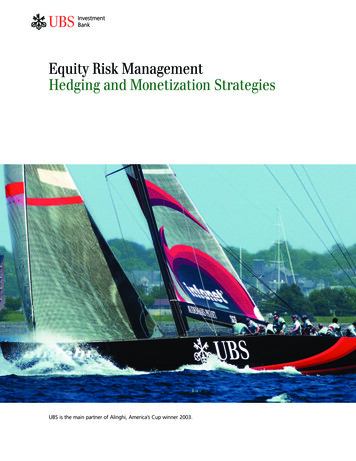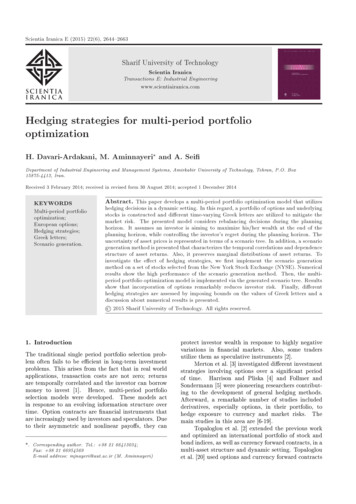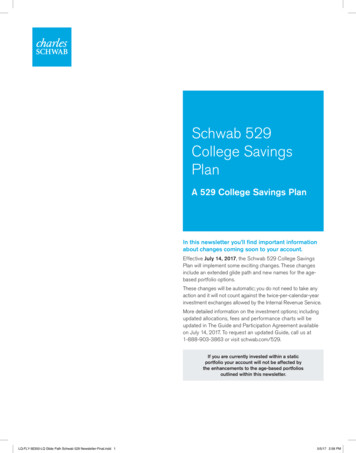
Transcription
Equity Risk ManagementHedging and Monetization StrategiesUBS is the main partner of Alinghi, America’s Cup winner 2003.
ContentsI. IntroductionConcentrated Assets — Maximize the Power, Minimize the Risk . . . . . . . . . . . . .1The Advantages of Equity Risk Management . . . . . . . . . . . . . . . . . . . . . . . . . . . .2Serving Diverse Investor Needs . . . . . . . . . . . . . . . . . . . . . . . . . . . . . . . . . . . . . .3Case History: A Study in Personalization . . . . . . . . . . . . . . . . . . . . . . . . . . . . . . .4II. Equity Risk Management StrategiesOverview Chart of Equity Risk Management Strategies . . . . . . . . . . . . . . . . . . . .5Summary of Equity Risk Management Strategies . . . . . . . . . . . . . . . . . . . . . . . . .6III. Strategy DetailsRemain Unhedged . . . . . . . . . . . . . . . . . . . . . . . . . . . . . . . . . . . . . . . . . . . . . . .8Sale of Securities . . . . . . . . . . . . . . . . . . . . . . . . . . . . . . . . . . . . . . . . . . . . . . . . .8Sale of OTC Covered Call Options . . . . . . . . . . . . . . . . . . . . . . . . . . . . . . . . . . . .9Purchase of OTC Put Options . . . . . . . . . . . . . . . . . . . . . . . . . . . . . . . . . . . . . .10Zero-Premium Collars . . . . . . . . . . . . . . . . . . . . . . . . . . . . . . . . . . . . . . . . . . . .11Maximum Monetization and Asset Protection (MMAP) . . . . . . . . . . . . . . . . . . .13IV. Frequently Asked Questions . . . . . . . . . . . . . . . . . . . . . . . . . . . . . . . . . .17V. Tax ConsiderationsApplicable Tax Legislation and Straddle Rules . . . . . . . . . . . . . . . . . . . . . . . . . .18Tax Consequence Scenario Analysis . . . . . . . . . . . . . . . . . . . . . . . . . . . . . . . . . .19VI. Legal and Regulatory IssuesRules 144 and 144(k) . . . . . . . . . . . . . . . . . . . . . . . . . . . . . . . . . . . . . . . . . . . .21Rule 145 . . . . . . . . . . . . . . . . . . . . . . . . . . . . . . . . . . . . . . . . . . . . . . . . . . . . . .22Considerations for Insiders . . . . . . . . . . . . . . . . . . . . . . . . . . . . . . . . . . . . . . . .23Rule 10b5-1 . . . . . . . . . . . . . . . . . . . . . . . . . . . . . . . . . . . . . . . . . . . . . . . . . . .24Additional Issues and Eligibility . . . . . . . . . . . . . . . . . . . . . . . . . . . . . . . . . . . . .25VII. The Businesses of UBS . . . . . . . . . . . . . . . . . . . . . . . . . . . . . . . . . . . . . . .26
Introduction 1I. IntroductionConcentrated Assets — Maximize the Power, Minimize the RiskHigh-profile initial public offerings andstock-for-stock acquisitions have leftmany individuals with an enviable,yet precarious, position of owninglarge concentrations of a single stock.Unfortunately, the inability to sell —whether due to insider status, capitalgains implications or legal restrictions— can make managing the risks associated with these holdings complicated.In a time when our U.S. equity marketsare characterized by unprecedentedgrowth and volatility, how do youprotect the value of your large positionsand enhance investment flexibility?That’s where UBS can help.You and us —A Powerful PartnershipYour circumstances and goals are unlikeanybody else’s. At UBS, we take time tofind out about your needs and createan equity risk management strategy thatmakes sense for you. We remain focusedon you and how we can best optimizeyour concentrated equity positions.We utilize strategies which can: Protect against declines in stock value Enhance returns by “monetizing”a stock position Allow for diversification Increase borrowing capacity Defer costly capital gains taxesWhy UBS? Consistently recognizedas a leader in Equity RiskManagement Strength of credit rating(S&P: AA , Fitch: AA ,Moody’s: Aa2)— Peace of mindfor our investors Globally integrated presencein all major financial markets— Some 70,000employees around theworld, 40% in the U.S. High caliber andexperience of sales teamprofessionals Awarded “Best GlobalRisk Management House”by Euromoney, 2005UBS is a world-leading financial powerhouse withthe heart and soul of a two-person organization. OurEquity Risk Management Team will work hand-in-hand,employing their financial acumen and analyticalinsight to tailor the best strategy for you.
2 IntroductionThe Advantages of Equity Risk ManagementEquity Risk Managementdelivers two significantbenefits. It allows you toutilize strategies that protect your holdings and, atthe same time, enhancesinvestment flexibility.Liquidity StrategiesProvide DiversificationDiversification is the key to enhancedinvestment flexibility. UBS offers solutions that provide access to cash — tobuy stock in other companies or simplyenjoy life’s rewards. There is no need tosell shares and incur capital gains taxesor surrender the privileges of holdingthe stock.Hedging Strategies Limit RiskTo limit downside risk, UBS also offersa variety of hedging tools with expertisein execution. We provide a customizedstrategy designed to meet your uniqueneeds and objectives.In addition, UBS can create a programthat limits potential losses whilesimultaneously enhancing liquidity.All of our risk management strategiesare structured as over-the-counter(OTC) transactions and are not listedon any options exchange. The OTCoption market has the following advantages over listed option markets: Flexibility: The OTC market providesthe ultimate flexibility with regard todetermining price and maturity. Liquidity: The OTC market is as liquid as the liquidity of the underlyingstock. European Style: Exercisable atmaturity, there is no risk of earlyexercise in the OTC market.The Power of DiversificationThe true power of diversification lies inits ability to target an expected returnwhile reducing the exposure to risk.This chart depicts 10 individual stocksand their expected returns and associated volatility. The blue line representsa diversified portfolio holding variouscombinations of these 10 assets. Aninvestor holding any one of theseindividual stocks (we’ve used A in ourexample) would clearly be better offdiversifying to create a portfolio thatoffers the same potential rewards withless risk (point B).14%Expected Return12%10%AB8%6%4%2%0%0%10%20%Risk (volatility)Well-diversified portfolio of stocksIndividual stocks30%40%
Introduction 3Serving Diverse Investor NeedsEquity Risk Management solutions canaccommodate a variety of high networth investors holding large, concentrated positions. These include: Executives who were bought outfor stock: A company executive,founder or investor of an acquiredcompany who received shares of theacquirer as consideration in a mergertransaction. Individuals with leveragedpositions: An individual with anunprotected concentrated equityposition who carries margin debtcan restructure and eliminate thepossibility of margin calls. Initial investors: Initial investorswho own restricted or low-basisshares of an issuer who recentlyhad an initial public offering or amerger transaction. Current or retired executivesor employees: A current or formercompany executive or employee whohas accumulated a large amountof shares. Inheritance: A family who hasowned shares of a company for manyyears, perhaps even generations.Equity Risk Managementsolutions can accommodatea variety of high net worthinvestors.
4 IntroductionCase History:A Study in PersonalizationYou and us. It’s our primary focus atUBS. Our Equity Risk Managementsolutions are no exception. Here’sa case in point A long time investor in United ParcelService, Inc. (UPS), John had large holdings in the stock, as well as a significant position in FedEx Corp. (FDX). Atthe time he met with UBS, his holdingswere valued at 350 million, with margin debt of nearly 100 million. Johnwas bullish on the long-term prospectsof both companies, but was smartenough to realize that a short-termdecline might result in a forced liquidation of his stock at depressed prices.During his initial conversation with UBS,John was shown how the firm could: Reduce his existing margin expenseby moving the loan to UBS, and Reduce the risk of any margin call byhedging some or all of his position witha Maximum Monetization and AssetProtection (“MMAP”) transaction.This initial discussion was followed bya review, during which UBS evaluatedmultiple scenarios to determine whichstrategy most effectively: Minimized shares allocated to hedge(to retain upside) Eliminated margin call risk Significantly reduced financing costJohn’s original intention, to hedge halfhis FDX and half his UPS, proved to bethe most expensive and least effectivestrategy. The optimal result was tohedge his entire UPS position, whichgenerated the maximum liquidity. UBSexpedited John's strategy, completinghis documentation within days of hispending business trip, and acted upontrading instructions to meet John'sobjectives. Despite a volatile market,UBS exceeded John’s expectations onthe execution of the deal.UBS was able to add value by: Delivering expert and objective ideas Focusing on what’s right forthe client Providing personal service with greatattention to detail Timely execution
Equity Risk Management Strategies 5II. Equity Risk Management StrategiesOverview Chart of Equity Risk Management StrategiesConcentrated Equity PositionCollarsMMAPsGeneratescash flowGeneratescash flowNo ceiling onupside exposureCan be structuredwith zero up-frontcostSubstantial liquiditygenerated up-frontRemovesdownside riskNo tax eventuntil maturityNo tax eventuntil maturityNo tax eventuntil maturityNo tax eventuntil maturityProvides floorfor stock priceProvides floorfor stock priceProvides floorfor stock pricePotentiallysignificantup-front costCeiling onupside exposureCeiling onupside exposureRecognizescapital gainCeiling onupside exposureEliminates upsideexposureDoes notfully hedgedownside riskDiscounted ifshares restrictedUpside influencedby option pricing,not the clientProtected stock position facilitatescollateralized lending arrangementSelf-financing:No separate loanvehicle requiredBenefitsPurchaseof PutsConsiderationsSaleof Covered CallsFinancingSaleof Position
6 Equity Risk Management StrategiesSummary of Equity Risk StrategiesRemain UnhedgedSale of PositionSale of OTC Covered Call Options1Investor ProfileThis strategy may be right for a highnet worth individual who is extremelybullish on the underlying stock, andwho is willing to accept the risk ofa dramatic stock price decline.Investor ProfileThis strategy may be right for a highnet worth individual who is bearish andwho believes the stock price will likelyfall over the medium to long-term.Investor ProfileThis strategy may be right for a highnet worth individual who is mildlybullish on the underlying asset positionand wishes to enhance its “yield.”ActionFor the investor holding freely tradable,unrestricted shares, simply sell theshares, pay taxes and reinvest thenet proceeds.ActionImplement a strategy of selling OTCcovered call options.In light of the recentequity market performance, many investorsrecognize the prudenceof protecting at leasta portion of their concentrated stock position bypursuing an equity riskmanagement strategy.For the investor holding illiquid securities, including restricted stock subjectto Rule 144, call options or warrants,there may be possible sale opportunities — UBS may be able to privatelypurchase restricted securities from nonaffiliates at a discount to the currentmarket price, thereby creating immediate liquidity.Benefits Cash flow is generated No tax event until maturityConsiderations Ceiling on upside exposure Downside risk is not fully hedgedBenefits Cash flow is generated Downside risk is removedConsiderations Creation of a recognized capital gain Upside exposure is eliminated Sale price may be discountedif shares restrictedNote:1See Section V, Tax Considerations.
Equity Risk Management Strategies 7Purchase of OTC Put Options1Zero-Premium Collars2Maximum Monetization andAsset Protection (MMAP)1Investor ProfileThis may be right for a high net worthindividual who is bullish on the underlying stock and who does not want tobe exposed to unforeseen downwardprice movements.Investor ProfileThis may be right for a high net worthindividual who is moderately bullish onthe underlying stock, and who wishesto protect the value of the positionwithout paying option premium.ActionImplement a strategy of purchasingOTC put options.ActionImplement a strategy of zero-premiumcollars.Investor ProfileThis may be right for a high net worthindividual who is optimistic about theprospects of the stock, but who wishesto protect the value of a concentratedequity position and maximize monetization proceeds and diversificationpossibilities.Benefits Upside exposure has no ceiling No tax event until maturity Provides floor for stock priceBenefits Can be structured with zeroup-front cost No tax event until maturity(assuming no early unwind) Provides floor for stock priceConsiderations Potentially significant up-front costs Protected stock position facilitatescollateralized lending arrangementNote:1See Section V, Tax Considerations.2See Section V, Tax Considerations, whichcontemplates documenting the collar as asingle-pay contract.Considerations Ceiling on upside exposure Upside determined by option pricing,not the client Protected stock position facilitatescollateralized lending agreementActionImplement a strategy of MaximumMonetization and Asset Protection —generically known as a variable pre-paidforward sale.Benefits Substantial liquidity generatedup-front No tax event until maturity(assuming no early unwind) Provides floor for stock priceConsiderations Ceiling on upside exposure Self-financing: no separate loanvehicle required
8 Strategy DetailsIII. Strategy DetailsRemain UnhedgedThe investor who is extremely bullishon the underlying stock and is willingto accept the risk of a dramatic stockprice decline should simply do nothingon 100% of their position.Equity Market PerformanceS&P 500IndexNASDAQCompositeIndex16005500S&P 500 Index1500NASDAQ Composite 061000Source: Bloomberg, May, 2006In light of the recent equity Sale of Securitiesmarket performance, manyinvestors recognize theFreely Tradable The investor who owns freely tradprudence of protectingable unrestricted shares and believesat least a portion of theirthe stock price will likely fall over theconcentrated stock position. medium to long-term should simplysell the shares, pay taxes and reinvestTherefore, many investorsthe net proceeds.pursue one of the strategiesdiscussed in this sectionfor at least a percentageof their holdings.Illiquid Securities Many investors hold illiquid securitiesincluding restricted stock subject toRule 144, call options or warrantsand are unaware of possible saleopportunities. In certain situations,UBS may be able to facilitate thesale of restricted securities in theopen market. UBS may be able to privately purchase restricted securities fromnon-affiliates at a discount to thecurrent market price, thereby creatingimmediate liquidity for the investor. The amount of the discount is determined primarily by liquidity of theunderlying security, borrow costs,market interest rates and the remaining length of the restricted period.Trade date will be the effective saledate, triggering a taxable event forthe investor.
Strategy Details 9Sale of OTC Covered Call Options1The sale of covered call options is bestsuited for the investor who is mildlybullish and wishes to enhance the“yield” on the underlying asset position. While the sale of covered callsgenerates up-front premium income,it should not be considered a hedgeof downside risk.The owner of a European-style calloption has the right to buy the stockon a certain date for a pre-determinedprice (the call strike). The seller of acall option will forego any appreciationabove the call strike. When an investorsells calls on shares he/she alreadyowns outright, the calls are “covered.”For example, the sale of a six-monthcall option which limits the seller to thefirst 10% of appreciation might generate a premium of 3%–6%, payable upfront in cash (assuming a zero dividend,moderately volatile stock).The sale of an out-of-the-money covered call option will not immediatelytrigger a taxable event. Unlike listedcall options, European-style call optionsmay be settled either in cash or physicalform, at maturity. Exercise occurs if thefinal market price is higher than thecall strike. With cash settlement, theinvestor pays to UBS the differencebetween the call strike and the finalmarket price. For physical settlement,the investor delivers the stock to UBSand receives cash equal to the callstrike. Physical settlement is an actualsale of the underlying shares whilecash settlement is not.The graph below assumes an initialprice of 100 and the investor receiveda call premium.CappedIf stock finishesabove call strike,investor pays UBS(final price less 110)at maturityCall Strike 110Investor retains first 10 of appreciationInitial Price 100ExposedIf stock falls,investor exposedto downside riskNote:1See Section V, Tax Considerations.At maturity, if thefinal price is 110or lower, the callexpires withoutvalue and there areno payments.
10 Strategy DetailsPurchase of OTC Put Options1The investor who is bullish on theunderlying stock but does not wish tobe exposed to unforeseen downwardprice movements should consider thepurchase of put options. Purchasinga put option will effectively guaranteea minimum value for the asset. Theowner of a European-style put optionhas the right to sell the stock on acertain date for a pre-determinedprice (the put strike).For example, a two-year put optionthat provides 90% protection may cost15% to 25% or more, payable upfront in cash (assuming a zero dividend,moderately volatile stock).The purchase of an out-of-the-moneyput option will not trigger a taxableevent. Unlike listed put options, European-style put options may be settledeither in cash or physical form, if exercised at maturity. Exercise occurs if thefinal market price is below the putstrike. With cash settlement, theinvestor receives from UBS the difference between the put strike and thefinal market price. For physical settlement, the investor delivers the stock toUBS and receives cash equal to the putstrike. Physical settlement is considereda sale of the underlying shares at theput strike while cash settlement is not.The graph below assumes an initialprice of 100 and the investor paida put premium.Full UpsideIf stock is up,investor retains100% ofappreciationInitial Price 100Investor exposed to first 10 of depreciationPut Strike 90ProtectedIf stock finishesbelow put strike,UBS pays investor( 90 less final price)at maturityMonetization for Put OptionsThe combination of long stock and aput option creates a creditworthy asset.During the life of the put option, UBSwill generally lend up to a maximum ofNote:1See Section V, Tax Considerations.90% of the protected value (the putstrike) for non-purpose credit on unrestricted shares. If the loan is to be usedfor purpose credit (the purchase ofmargin securities) the maximum loanAt maturity, if thefinal price is 90or higher, the putexpires withoutvalue and there areno payments.amount is restricted to 50% of themarket value of the underlying stock atthe time of borrowing.
Strategy Details 11Zero-Premium Collars1The investor who is moderately bullishbut wishes to protect the value of aparticular equity position without paying option premium should consider anequity collar. Many investors like theprotection afforded by the purchase ofa put option but do not wish to paythe up-front premium required. If willing to forego appreciation above a certain level, the investor can sell a calloption to generate premium income.When the cost of purchasing a putoption is fully funded by selling a calloption, the transaction is referred toas a “zero-premium collar.”During the life of the collar, theinvestor retains ownership, votingrights and dividends (however, oftencapped at the current level on tradedate) on the underlying shares.For example, an investor owns stockwith a market price of 100 and wantsto limit his downside risk to 10%.The investor purchases a two-yearEuropean-style put option with a strikeprice of 90 and simultaneously sellsa two-year European-style call optionwith a call strike of 120 (the calculated level necessary to generate callpremium income which fully offsets theput premium cost). For 0.00 out-ofpocket cost, the investor’s exposure isprotected at 90 and below, cappedat 120 and above, and fully exposedin between.CappedIf stock finishes abovecall strike, investor paysUBS (final price less 120) at maturityCall Strike 120Investor retains first 20 of appreciation Initial Price 100and is exposed to first 10 of depreciation.Put Strike 90ProtectedIf stock finishes belowput strike, UBS paysinvestor ( 90 less finalprice) at maturityAt maturity, if thefinal price is at orbetween 90 and 120, both the calland put optionsexpire withoutvalue and there areno payments.Continued on following page.Note:1See Section V, Tax Considerations, whichcontemplates documenting the collar asa single-pay contract.
12 Strategy DetailsZero-Premium CollarsContinued from previous page.Many tax advisors have the opinionthat entering into a zero-premiumcollar which has at least a 15% to20% spread between the call strikeand put strike will not create a taxableevent. As with separate put and calloptions, the zero-premium collar maybe cash or physically settled.Monetization ofZero-Premium CollarsSince the collar protects the underlyingstock, it becomes a very credit-worthyasset, thus, combining a loan with acollar will provide monetization and anopportunity for diversification.During the term of the zero-premiumcollar, UBS will generally lend up to amaximum of 90% of the protectedvalue (the put strike) for non-purposecredit (i.e., for the purchase of investments other than margin securities).If the loan is to be used for purposecredit (i.e., the purchase of marginsecurities) the maximum loan amountwill be limited to 50% of the marketvalue of the underlying stock at theCappedCall Strike 120Investor retains first 20 of appreciation.Initial Price 100and is exposed to first 10 of depreciation.Put Strike 90Non-PurposeLoan Proceeds 81PurposeLoan Proceeds 50Protectedtime of borrowing. Investors seekingmore than 50% should consider theMMAP transaction described on thefollowing page.Based on the prior example, the 90put strike would allow for a maximumloan amount of 81 for non-purposecredit (assuming unrestricted shares arehedged) and 50 for purpose credit.There is no risk of a margin call whena non-purpose loan is secured by azero-premium collar.
Strategy Details 13Maximum Monetization and Asset Protection (MMAP)1The MMAP transaction, genericallyknown as a variable pre-paid forwardsale, is the most common method ofhedging and monetizing used today.The MMAP is best suited for the investor who is optimistic about theprospects for their stock, but wishesto protect the value of a concentratedequity position and maximize theirmonetization proceeds and diversification possibilities.Rationale of the MMAPEnables investors to: Hedge the position Maintain upside exposure(as defined by the client) Extract up to 90% of the stock valuein cash without selling the underlying shares. The cash advanced to theclient is tax deferred and can be usedfor any purpose. Typical objectivesinclude diversification or eliminationof margin debt.Components of the MMAP DiscountThe up-front discount of the MMAP ismade up of three components:1. Cost of Funds: present-valuediscount of the Lower Strike overthe term2. Cost of Hedge: credit or debitattributed to an equivalent collarpriced with Lower and Upper Strikesof the MMAP3. Dividend Yield: present-value ofany dividend cash flows are debitedChart Illustrates MMAP on a Stockwith No DividendTrade DateMaturityThree YearsUpper Strike 140Investor retains up to 40 of appreciationLower Strike 100Advance 85Present value of Lower Strike embedded collar value Advance AmountCash Flows of the MMAPThe cash flows of the MMAP areas follows: Trade Date: Client receives discountto the current stock price by agreeingto deliver a variable amount of theunderlying stock (or equivalent cashamount) at the maturity date.them through to UBS. Most clientselect to cap the dividends at the levelpaid at the time of execution. Maturity: Client delivers variableamount of underlying shares (orequivalent cash amount) per thesettlement scenarios illustrated inthe following page. Over the Life of the MMAP: Clientmay either receive dividends or passNote:1See Section V, Tax Considerations.Continued on following page.
14 Strategy DetailsMaximum Monetization and Asset Protection (MMAP)Continued from previous page.The example shown here illustratesthe settlement for an investor whohas hedged 100,000 shares of a 100 stock and received 85 upfront in a MMAP transaction. Theinvestor chose a Lower Strike of 100 and an Upper Strike of 140to retain up to 40 per share invalue at maturity. If the investor chooses cashsettlement, the investor willpay the amount in Column C If the investor chooses physicalsettlement, the investor willdeliver the number of shares inColumn B, while retaining thenumber of shares in Column DUpper LimitLower LimitABCDEStockprice atmaturity( )Numberof sharesinvestordeliversValue of sharesdelivered/cashsettlement amount( )Numberof sharesinvestorretainsValue ofretainedshares( ––––
Strategy Details 15Monetizationfor the MMAPUnlike the collar, the MMAP transactionrequires no separate loan facility to generate liquidity. Monetization for theMMAP comes via the up-front advance.amount of 85. Thus, in this example,the MMAP provides 70% more liquiditythan the collar for investment in publicly traded equities ( 85 for the MMAPvs. 50 for the collar).In the example on the previous page,the investor receives an advanceComparative Analysis:MMAP vs. Collar with LoanConcentrated Equity PositionMMAPCollar with LoanAsset ProtectionYesYesAvailable ProceedsUp to 90% — dependent onupside retained50% of market value (purpose credit)90% of put strike value forunrestricted shares (non-purpose credit)Maintain Current Dividend (capped)YesYesCollateral RequiredYesYesTax DeferralYesYesRetain AppreciationYes — determined by client (capped)Yes — determined by option pricing(capped)Maintain OwnershipYesYesOngoing Interest PaymentsNoYesMargin CallsNoNoSeparate Loan-PaperworkNoYesContinued on following page.
16 Strategy DetailsMaximum Monetization and Asset Protection (MMAP)Continued from previous page.Summary ofAfter-Tax AnalysisThe MMAP vs. Sale after-tax analysis isbased on a hypothetical assumption ofa three-year 100/140% MMAP whichraises 85% up-front on a stock witha 0.00 tax basis. This transaction iscompared against a sale of the samestock. The after-tax analysis is summarized as follows: Breakeven: This is the annual stockgrowth required for the MMAP transaction to be the same as a sale onan after-tax basis. For this example,the stock would have to grow byapproximately 4.2% for the MMAPand sale after-tax performance tobe identical. MMAP Outperformance: The darkgreen shaded area represents theafter-tax MMAP outperformanceover a sale if the annual stock growthexceeds 4.2%. The maximum absoluteoutperformance for this exampleis 2mm. Sale Outperformance: The areashaded light green represents theafter-tax sale outperformance overthe MMAP if the annual stockgrowth is less than 4.2%. Thisillustration shows the maximumunderperformance for the MMAPis under 1mm regardless of howlow the underlying stock falls.Hypothetical ComparativeAfter-Tax Analysis — MMAP v. SaleMMAP OutperformanceSale )(2.1)(0.7)0.72.13.54.96.37.7Annual Stock Growth (%)9.110.511.913.314.7
Frequently Asked Questions 17IV. Frequently Asked QuestionsWhat is “equity risk management?”Equity risk management, or stock hedging, is a way for investors to reduce andmanage price risk in concentrated stockpositions. Although holding a stock position without interruption may haveresulted in significant net worth, it is prudent to explore strategies to reduce riskin the biggest component of an investors’net worth, and review methods to createliquidity in a tax-efficient manner.Can I “roll” into a new MMAP atmaturity?Generally, yes. Many investors who electto deliver cash and retain their stock willraise the cash by entering into a newtransaction at maturity. As the stockprice rises, the lower and upper limitprices will be reset at the newer, higherlevels, and the investor will receive anew up-front payment. This paymentwil
All of our risk management strategies are structured as over-the-counter (OTC) transactions and are not listed on any options exchange. The OTC option market has the following advan-tages over listed option markets: Flexibility: The OTC market provides the ultimate flexibility with regard to determining price and maturity.











